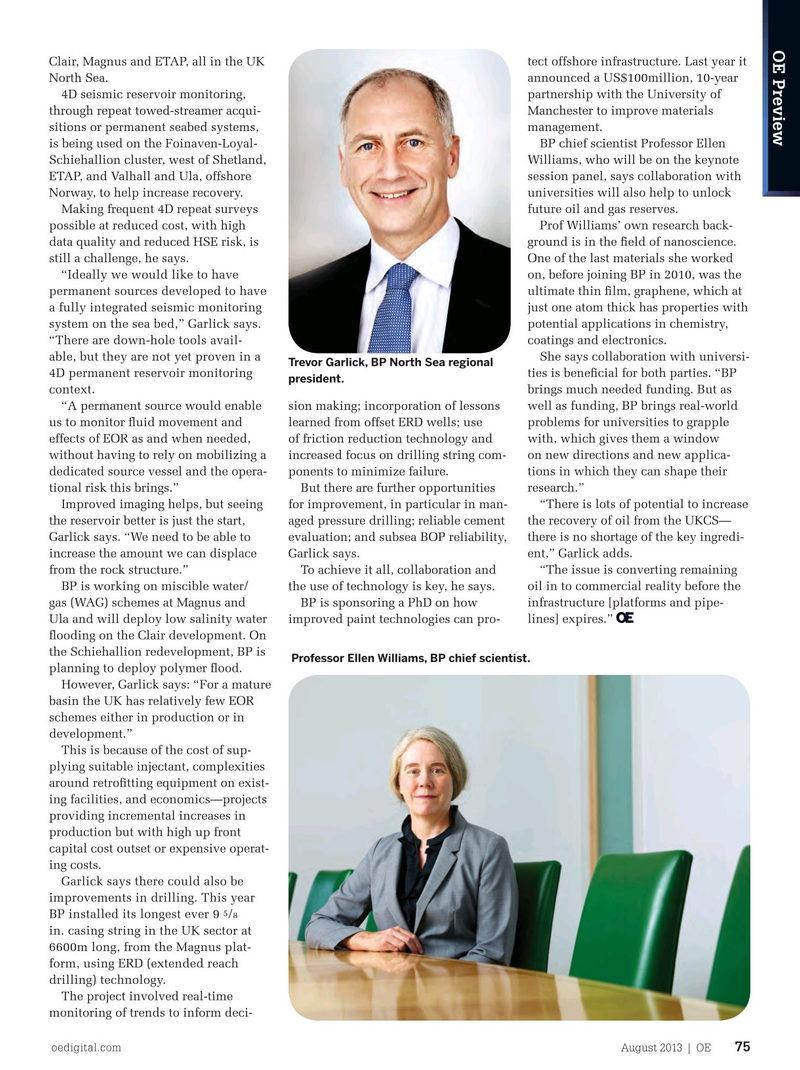
Page 73: of Offshore Engineer Magazine (Aug/Sep 2013)
Read this page in Pdf, Flash or Html5 edition of Aug/Sep 2013 Offshore Engineer Magazine
OE Preview
Clair, Magnus and ETAP, all in the UK tect offshore infrastructure. Last year it
North Sea. announced a US$100million, 10-year 4D seismic reservoir monitoring, partnership with the University of through repeat towed-streamer acqui- Manchester to improve materials sitions or permanent seabed systems, management. is being used on the Foinaven-Loyal- BP chief scientist Professor Ellen
Schiehallion cluster, west of Shetland, Williams, who will be on the keynote
ETAP, and Valhall and Ula, offshore session panel, says collaboration with
Norway, to help increase recovery. universities will also help to unlock
Making frequent 4D repeat surveys future oil and gas reserves. possible at reduced cost, with high Prof Williams’ own research back- data quality and reduced HSE risk, is ground is in the feld of nanoscience. still a challenge, he says. One of the last materials she worked “Ideally we would like to have on, before joining BP in 2010, was the permanent sources developed to have ultimate thin flm, graphene, which at a fully integrated seismic monitoring just one atom thick has properties with system on the sea bed,” Garlick says. potential applications in chemistry, “There are down-hole tools avail- coatings and electronics.
able, but they are not yet proven in a She says collaboration with universi-
Trevor Garlick, BP North Sea regional 4D permanent reservoir monitoring ties is benefcial for both parties. “BP president. context. brings much needed funding. But as “A permanent source would enable sion making; incorporation of lessons well as funding, BP brings real-world us to monitor fuid movement and learned from offset ERD wells; use problems for universities to grapple effects of EOR as and when needed, of friction reduction technology and with, which gives them a window without having to rely on mobilizing a increased focus on drilling string com- on new directions and new applica- dedicated source vessel and the opera- ponents to minimize failure. tions in which they can shape their tional risk this brings.” But there are further opportunities research.”
Improved imaging helps, but seeing for improvement, in particular in man- “There is lots of potential to increase the reservoir better is just the start, aged pressure drilling; reliable cement the recovery of oil from the UKCS—
Garlick says. “We need to be able to evaluation; and subsea BOP reliability, there is no shortage of the key ingredi- increase the amount we can displace Garlick says. ent,” Garlick adds.
from the rock structure.” To achieve it all, collaboration and “The issue is converting remaining
BP is working on miscible water/ the use of technology is key, he says. oil in to commercial reality before the gas (WAG) schemes at Magnus and BP is sponsoring a PhD on how infrastructure [platforms and pipe-
Ula and will deploy low salinity water improved paint technologies can pro- lines] expires.” fooding on the Clair development. On the Schiehallion redevelopment, BP is Professor Ellen Williams, BP chief scientist.
planning to deploy polymer food.
However, Garlick says: “For a mature basin the UK has relatively few EOR schemes either in production or in development.”
This is because of the cost of sup- plying suitable injectant, complexities around retroftting equipment on exist- ing facilities, and economics—projects providing incremental increases in production but with high up front capital cost outset or expensive operat- ing costs.
Garlick says there could also be improvements in drilling. This year 5 8
BP installed its longest ever 9 / in. casing string in the UK sector at 6600m long, from the Magnus plat- form, using ERD (extended reach drilling) technology.
The project involved real-time monitoring of trends to inform deci- oedigital.com August 2013 | OE 75 074_OE013_Offshore-Europe.indd 75 7/22/13 1:22 PM

 72
72

 74
74